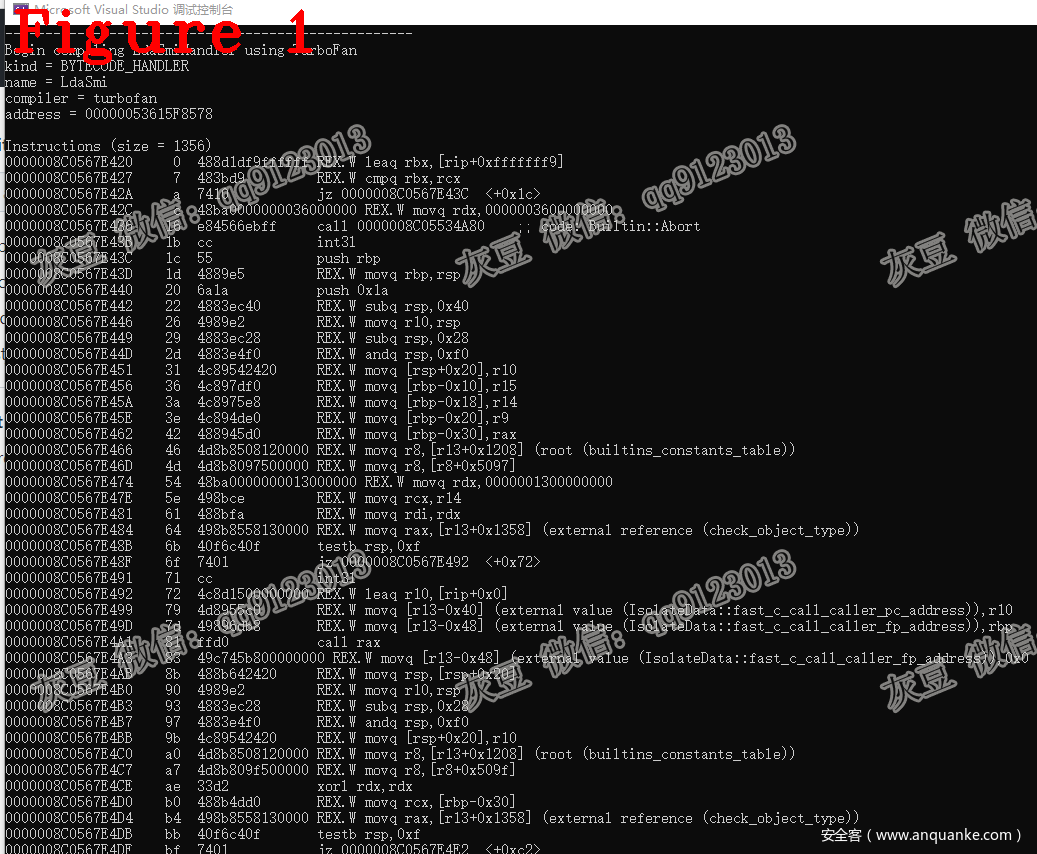
1 摘要
本篇文章是 Builtin 专题的第七篇。上篇文章讲解了 Builtin::kInterpreterEntryTrampoline 源码,本篇文章将介绍 Builin 的编译过程,在此过程中可以看到 Bytecode hanlder 生成 code 的技术细节,同时也可借助此过程了解 Compiler Pipeline 技术和重要数据结构。
2 Bytecode handler的重要数据结构
GenerateBytecodeHandler()负责生成Bytecode hander,源码如下:
1. Handle<Code> GenerateBytecodeHandler(Isolate* isolate, const char* debug_name,
2. Bytecode bytecode,
3. OperandScale operand_scale,
4. int builtin_index,
5. const AssemblerOptions& options) {
6. Zone zone(isolate->allocator(), ZONE_NAME);
7. compiler::CodeAssemblerState state(
8. isolate, &zone, InterpreterDispatchDescriptor{}, Code::BYTECODE_HANDLER,
9. debug_name,
10. FLAG_untrusted_code_mitigations
11. ? PoisoningMitigationLevel::kPoisonCriticalOnly
12. : PoisoningMitigationLevel::kDontPoison,
13. builtin_index);
14. switch (bytecode) {
15. #define CALL_GENERATOR(Name, ...) \
16. case Bytecode::k##Name: \
17. Name##Assembler::Generate(&state, operand_scale); \
18. break;
19. BYTECODE_LIST(CALL_GENERATOR);
20. #undef CALL_GENERATOR
21. }
22. Handle<Code> code = compiler::CodeAssembler::GenerateCode(&state, options);
23. #ifdef ENABLE_DISASSEMBLER
24. if (FLAG_trace_ignition_codegen) {
25. StdoutStream os;
26. code->Disassemble(Bytecodes::ToString(bytecode), os);
27. os << std::flush;
28. }
29. #endif // ENABLE_DISASSEMBLER
30. return code;
31. }
上述代码第 7-13 行初始化 state,state 中包括 BytecodeOffset、 DispatchTable 和 Descriptor,Bytecode 编译时会使用state。 第 14-21 行代码生成 Bytecode handler 源码。第 17 行 state 作为参数传入 GenerateCode() 中,用于记录 Bytecode hadler 的生成结果。下面以 LdaSmi 为例讲解 Bytecode handler 的重要数据结构:
IGNITION_HANDLER(LdaSmi, InterpreterAssembler) {
TNode<Smi> smi_int = BytecodeOperandImmSmi(0);
SetAccumulator(smi_int);
Dispatch();
}
上述代码将累加寄存器的值设置为 smi。展开宏 IGNITION_HANDLER 后可以看到 LdaSmiAssembler 是子类,InterpreterAssembler 是父类,说明如下:
(1) LdaSmiAssembler 中包括生成 LdaSmi 的入口方法 Genrate(),源码如下:
1.void Name##Assembler::Generate(compiler::CodeAssemblerState* state,
1. OperandScale scale) {
2. Name##Assembler assembler(state, Bytecode::k##Name, scale);
3. state->SetInitialDebugInformation(#Name, __FILE__, __LINE__);
4. assembler.GenerateImpl();
6.}
上述第3行代码创建 LdaSmiAssembler 实例。第4行代码把 debug 信息写入state。
(2) InterpreterAssembler 提供解释器相关的功能,源码如下:
1. class V8_EXPORT_PRIVATE InterpreterAssembler : public CodeStubAssembler {
2. public:
3. //.............省略.........................
4. private:
5. TNode<BytecodeArray> BytecodeArrayTaggedPointer();
6. TNode<ExternalReference> DispatchTablePointer();
7. TNode<Object> GetAccumulatorUnchecked();
8. TNode<RawPtrT> GetInterpretedFramePointer();
9. compiler::TNode<IntPtrT> RegisterLocation(Register reg);
10. compiler::TNode<IntPtrT> RegisterLocation(compiler::TNode<IntPtrT> reg_index);
11. compiler::TNode<IntPtrT> NextRegister(compiler::TNode<IntPtrT> reg_index);
12. compiler::TNode<Object> LoadRegister(compiler::TNode<IntPtrT> reg_index);
13. void StoreRegister(compiler::TNode<Object> value,
14. compiler::TNode<IntPtrT> reg_index);
15. void CallPrologue();
16. void CallEpilogue();
17. void TraceBytecodeDispatch(TNode<WordT> target_bytecode);
18. void TraceBytecode(Runtime::FunctionId function_id);
19. void Jump(compiler::TNode<IntPtrT> jump_offset, bool backward);
20. void JumpConditional(compiler::TNode<BoolT> condition,
21. compiler::TNode<IntPtrT> jump_offset);
22. void SaveBytecodeOffset();
23. TNode<IntPtrT> ReloadBytecodeOffset();
24. TNode<IntPtrT> Advance();
25. TNode<IntPtrT> Advance(int delta);
26. TNode<IntPtrT> Advance(TNode<IntPtrT> delta, bool backward = false);
27. compiler::TNode<WordT> LoadBytecode(compiler::TNode<IntPtrT> bytecode_offset);
28. void DispatchToBytecodeHandlerEntry(compiler::TNode<RawPtrT> handler_entry,
29. compiler::TNode<IntPtrT> bytecode_offset);
30. int CurrentBytecodeSize() const;
31. OperandScale operand_scale() const { return operand_scale_; }
32. Bytecode bytecode_;
33. OperandScale operand_scale_;
34. CodeStubAssembler::TVariable<RawPtrT> interpreted_frame_pointer_;
35. CodeStubAssembler::TVariable<BytecodeArray> bytecode_array_;
36. CodeStubAssembler::TVariable<IntPtrT> bytecode_offset_;
37. CodeStubAssembler::TVariable<ExternalReference> dispatch_table_;
38. CodeStubAssembler::TVariable<Object> accumulator_;
39. AccumulatorUse accumulator_use_;
40. bool made_call_;
41. bool reloaded_frame_ptr_;
42. bool bytecode_array_valid_;
43. DISALLOW_COPY_AND_ASSIGN(InterpreterAssembler);
44. };
上述第 5 行代码获取 BytecodeArray 的地址;第 6 行代码获取 DispatchTable 的地址;第 7 行代码获取累加寄存器的值;第8-13行代码用于操作寄存器;第 15-16 行代码用于调用函数前后的堆栈处理;第 17-18 行代码用于跟踪 Bytecode,其中第18行会调用Runtime::RuntimeInterpreterTraceBytecodeEntry以输出寄存器信息;第 19-20 行代码是两条跳转指令,在该指令的内部调用 Advance(第24-26行)来完成跳转操作;第 24-26 行代码用于获取下一条 Bytecode;第 32-42 行代码定义的成员变量在 Bytecode handler 中会被频繁使用,例如在 SetAccumulator(zero_value) 中先设置 accumulator_use 为写状态,再把值写入 accumulator_。
(3) CodeStubAssembler 是 InterpreterAssembler 的父类,提供 JavaScript 的特有方法,源码如下:
1. class V8_EXPORT_PRIVATE CodeStubAssembler: public compiler::CodeAssembler,
2. public TorqueGeneratedExportedMacrosAssembler {
3. public:
4. TNode<Int32T> StringCharCodeAt(SloppyTNode<String> string,
5. SloppyTNode<IntPtrT> index);
6. TNode<String> StringFromSingleCharCode(TNode<Int32T> code);
7. TNode<String> SubString(TNode<String> string, TNode<IntPtrT> from,
8. TNode<IntPtrT> to);
9. TNode<String> StringAdd(Node* context, TNode<String> first,
10. TNode<String> second);
11. TNode<Number> ToNumber(
12. SloppyTNode<Context> context, SloppyTNode<Object> input,
13. BigIntHandling bigint_handling = BigIntHandling::kThrow);
14. TNode<Number> ToNumber_Inline(SloppyTNode<Context> context,
15. SloppyTNode<Object> input);
16. TNode<BigInt> ToBigInt(SloppyTNode<Context> context,
17. SloppyTNode<Object> input);
18. TNode<Number> ToUint32(SloppyTNode<Context> context,
19. SloppyTNode<Object> input);
20. // ES6 7.1.17 ToIndex, but jumps to range_error if the result is not a Smi.
21. TNode<Smi> ToSmiIndex(TNode<Context> context, TNode<Object> input,
22. Label* range_error);
23. TNode<Smi> ToSmiLength(TNode<Context> context, TNode<Object> input,
24. Label* range_error);
25. TNode<Number> ToLength_Inline(SloppyTNode<Context> context,
26. SloppyTNode<Object> input);
27. TNode<Object> GetProperty(SloppyTNode<Context> context,
28. SloppyTNode<Object> receiver, Handle<Name> name) {}
29. TNode<Object> GetProperty(SloppyTNode<Context> context,
30. SloppyTNode<Object> receiver,
31. SloppyTNode<Object> name) {}
32. TNode<Object> SetPropertyStrict(TNode<Context> context,
33. TNode<Object> receiver, TNode<Object> key,
34. TNode<Object> value) {}
35. template <class... TArgs>
36. TNode<Object> CallBuiltin(Builtins::Name id, SloppyTNode<Object> context,
37. TArgs... args) {}
38. template <class... TArgs>
39. void TailCallBuiltin(Builtins::Name id, SloppyTNode<Object> context,
40. TArgs... args) { }
41. void LoadPropertyFromFastObject(...省略参数...);
42. void LoadPropertyFromFastObject(...省略参数...);
43. void LoadPropertyFromNameDictionary(...省略参数...);
44. void LoadPropertyFromGlobalDictionary(...省略参数...);
45. void UpdateFeedback(Node* feedback, Node* feedback_vector, Node* slot_id);
46. void ReportFeedbackUpdate(TNode<FeedbackVector> feedback_vector,
47. SloppyTNode<UintPtrT> slot_id, const char* reason);
48. void CombineFeedback(Variable* existing_feedback, int feedback);
49. void CombineFeedback(Variable* existing_feedback, Node* feedback);
50. void OverwriteFeedback(Variable* existing_feedback, int new_feedback);
51. void BranchIfNumberRelationalComparison(Operation op,
52. SloppyTNode<Number> left,
53. SloppyTNode<Number> right,
54. Label* if_true, Label* if_false);
55. void BranchIfNumberEqual(TNode<Number> left, TNode<Number> right,
56. Label* if_true, Label* if_false) {
57. }
58. };
CodeStubAssembler 利用汇编语言实现了 JavaScript 的特有方法。基类 CodeAssembler 对汇编语言进行封装, CodeStubAssembler 使用 CodeAssembler 提供的汇编功能实现了字符串转换、属性获取和分支跳转等 JavaScript 功能,这正是 CodeStubAssembler 的意义所在。
上述代码第 4-9 行实现了字符串的相关操作;第 11-18 行代码实现了类型转换;第 21-26 行实现了 ES 规范中的功能;第 27-38 行实现了获取和设置属性;第 39-43 行实现了 Builtin 和 Runtime API 的调用方法;第 45-50 行代码用于管理 Feedback;第 51-55 行实现了 IF 功能。
(4) CodeAssembler 封装了汇编功能,实现了 Branch、Goto 等功能,源码如下:
1. class V8_EXPORT_PRIVATE CodeAssembler {
2. void Branch(TNode<BoolT> condition,
3. CodeAssemblerParameterizedLabel<T...>* if_true,
4. CodeAssemblerParameterizedLabel<T...>* if_false, Args... args) {
5. if_true->AddInputs(args...);
6. if_false->AddInputs(args...);
7. Branch(condition, if_true->plain_label(), if_false->plain_label());
8. }
9. template <class... T, class... Args>
10. void Goto(CodeAssemblerParameterizedLabel<T...>* label, Args... args) {
11. label->AddInputs(args...);
12. Goto(label->plain_label());
13. }
14. void Branch(TNode<BoolT> condition, const std::function<void()>& true_body,
15. const std::function<void()>& false_body);
16. void Branch(TNode<BoolT> condition, Label* true_label,
17. const std::function<void()>& false_body);
18. void Branch(TNode<BoolT> condition, const std::function<void()>& true_body,
19. Label* false_label);
20. void Switch(Node* index, Label* default_label, const int32_t* case_values,
21. Label** case_labels, size_t case_count);
22. }
3 Compiler Pipeline
GenerateBytecodeHandler() 的第 22 行代码完成了对 Bytecode LdaSmi 的编译,源码如下:
1. Handle<Code> CodeAssembler::GenerateCode(CodeAssemblerState* state,
2. const AssemblerOptions& options) {
3. RawMachineAssembler* rasm = state->raw_assembler_.get();
4. Handle<Code> code;
5. Graph* graph = rasm->ExportForOptimization();
6. code = Pipeline::GenerateCodeForCodeStub(...省略参数...)
7. .ToHandleChecked();
8. state->code_generated_ = true;
9. return code;
10. }
11. //.............分隔线...................
12. MaybeHandle<Code> Pipeline::GenerateCodeForCodeStub(...省略参数...) {
13. OptimizedCompilationInfo info(CStrVector(debug_name), graph->zone(), kind);
14. info.set_builtin_index(builtin_index);
15. if (poisoning_level != PoisoningMitigationLevel::kDontPoison) {
16. info.SetPoisoningMitigationLevel(poisoning_level);
17. }
18. // Construct a pipeline for scheduling and code generation.
19. ZoneStats zone_stats(isolate->allocator());
20. NodeOriginTable node_origins(graph);
21. JumpOptimizationInfo jump_opt;
22. bool should_optimize_jumps =
23. isolate->serializer_enabled() && FLAG_turbo_rewrite_far_jumps;
24. PipelineData data(&zone_stats, &info, isolate, isolate->allocator(), graph,
25. nullptr, source_positions, &node_origins,
26. should_optimize_jumps ? &jump_opt : nullptr, options);
27. data.set_verify_graph(FLAG_verify_csa);
28. std::unique_ptr<PipelineStatistics> pipeline_statistics;
29. if (FLAG_turbo_stats || FLAG_turbo_stats_nvp) {
30. }
31. PipelineImpl pipeline(&data);
32. if (info.trace_turbo_json_enabled() || info.trace_turbo_graph_enabled()) {//..省略...
33. }
34. pipeline.Run<CsaEarlyOptimizationPhase>();
35. pipeline.RunPrintAndVerify(CsaEarlyOptimizationPhase::phase_name(), true);
36. // .............省略..............
37. PipelineData second_data(...省略参数...);
38. second_data.set_verify_graph(FLAG_verify_csa);
39. PipelineImpl second_pipeline(&second_data);
40. second_pipeline.SelectInstructionsAndAssemble(call_descriptor);
41. Handle<Code> code;
42. if (jump_opt.is_optimizable()) {
43. jump_opt.set_optimizing();
44. code = pipeline.GenerateCode(call_descriptor).ToHandleChecked();
45. } else {
46. code = second_pipeline.FinalizeCode().ToHandleChecked();
47. }
48. return code;
49. }
上述第 6 行代码进入Pipeline开始编译工作;第 13-29 用于设置 Pipeline 信息;第 32 行的使能标记在 flag-definitions.h 中定义,它们使用 Json 输出当前的编译信息;第 34-40 行代码实现了生成初始汇编码、对初始汇编码进行优化、使用优化后的数据再次生成最终代码等功能,注意 第 36 行代码省略了优化初始汇编码。图1给出了 LdaSmi 的编译结果。

技术总结
(1) 只有 v8_use_snapshot = false 时才能在 V8 中调试 Bytecode Handler 的编译过程;
(2) CodeAssembler 封装了汇编,CodeStubAssembler 封装了JavaScript特有的功能,InterpreterAssembler 封装了解释器需要的功能,在这三层封装之上是Bytecode Handler;
(3) V8 初始化时编译包括 Byteocde handler 在内的所有 Builtin。
好了,今天到这里,下次见。
个人能力有限,有不足与纰漏,欢迎批评指正
微信:qq9123013 备注:v8交流 邮箱:[email protected]
本文由 华域联盟 原创撰写:华域联盟 » 《Chrome V8源码》32.字节码和 Compiler Pipeline 的细节
转载请保留出处和原文链接:https://www.cnhackhy.com/129304.htm





